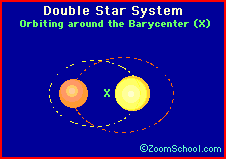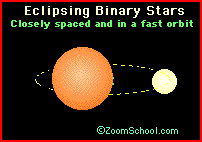what are the star classiication sizes from smallest to largest
Star Classification
The Lord's day is a as a G2V type star, a yellow dwarf and a principal sequence star.
O and B stars are uncommon but very vivid; M stars are mutual but dim..
An piece of cake mnemonic for remembering these is: "Oh exist a fine guy/daughter, osculation me."
Hertzsprung - Russell Diagram- Most stars, including the dominicus, are "main sequence stars," fueled past nuclear fusion converting hydrogen into helium. For these stars, the hotter they are, the brighter. These stars are in the most stable part of their existence; this stage generally lasts for near five billion years.
- Every bit stars begin to die, they get giants and supergiants (in a higher place the chief sequence). These stars take depleted their hydrogen supply and are very old. The cadre contracts equally the outer layers expand. These stars will somewhen explode (becoming a planetary nebula or supernova, depending on their mass) and and so get white dwarfs, neutron stars, or black holes (again depending on their mass).
- Smaller stars (similar our Sun) eventually become faint white dwarfs (hot, white, dim stars) that are below the main sequence. These hot, shrinking stars accept depleted their nuclear fuels and will eventually become cold, dark, black dwarfs.
| Star Type | Colour | Estimate Surface Temperature | Boilerplate Mass (The Sun = 1) | Average Radius (The Dominicus = 1) | Boilerplate Luminosity (The Lord's day = 1) | Main Characteristics | Examples |
|---|---|---|---|---|---|---|---|
| O | Blue | over 25,000 K | lx | 15 | ane,400,000 | Singly ionized helium lines (H I) either in emission or absorption. Stiff UV continuum. | 10 Lacertra |
| B | Blueish | 11,000 - 25,000 K | 18 | 7 | 20,000 | Neutral helium lines (H 2) in absorption. | Rigel Spica |
| A | Blue | 7,500 - 11,000 K | 3.two | 2.v | eighty | Hydrogen (H) lines strongest for A0 stars, decreasing for other A's. | Sirius, Vega |
| F | Blue to White | 6,000 - seven,500 K | 1.7 | 1.iii | half-dozen | Ca Ii absorption. Metal lines become noticeable. | Canopus, Procyon |
| G | White to Xanthous | 5,000 - 6,000 K | i.one | 1.one | 1.2 | Absorption lines of neutral metallic atoms and ions (e.yard. once-ionized calcium). | Sun, Capella |
| Thousand | Orange to Red | 3,500 - five,000 One thousand | 0.eight | 0.nine | 0.4 | Metal lines, some blueish continuum. | Arcturus, Aldebaran |
| M | Red | under 3,500 K | 0.3 | 0.four | 0.04 (very faint) | Some molecular bands of titanium oxide. | Betelgeuse, Antares |
Subtypes
Within each stellar type, stars are placed into subclasses (from 0 to 9) based on its position within the scale.
The Yerkes Luminosity Classes: (by William Wilson Morgan and Philip Keenan)
| TYPE | Star |
|---|---|
| Ia | Very luminous supergiants |
| Ib | Less luminous supergiants |
| 2 | Luminous giants |
| 3 | Giants |
| IV | Subgiants |
| V | Main sequence stars (dwarf stars) |
| 6 | Subdwarf |
| VII | White Dwarf |
Luminosity is the full brightness of a star (or galaxy). Luminosity is the total amount of energy that a star radiates each 2nd (including all wavelengths of electromagnetic radiation).
In the Yerkes classification scheme, stars are assigned to groups according to the width of their spectral lines. For a group of stars with the aforementioned temperature, the luminosity class differentiates betwixt their sizes (supergiants, giants, primary-sequence stars, and subdwarfs).
Main Sequence Stars - Immature StarsMain sequence stars are the central band of stars on the Hertzsprung-Russell Diagram. These stars' energy comes from nuclear fusion, as they convert Hydrogen to Helium. Most stars (about 90%) are Main Sequence Stars. For these stars, the hotter they are, the brighter they are. The dominicus is a typical Main Sequence star. DWARF STARS
Dwarf stars are relatively small stars, upward to twenty times larger than our sunday and up to 20,000 times brighter. Our dominicus is a dwarf star. YELLOW DWARF
A carmine dwarf is a pocket-sized, cool, very faint, main sequence star whose surface temperature is nether about four,000 K. Red dwarfs are the most common type of star. Proxima Centauri is a cerise dwarf. Giant and Supergiant Stars - Old, Large Stars
RED GIANT
A supergiant is the largest known type of star; some are almost as large equally our entire solar system. Betelgeuse and Rigel are supergiants. These stars are rare. When supergiants die they supernova and get black holes. Faint, Virtually Expressionless Stars:
WHITE DWARF
A white dwarf is a small, very dense, hot star that is made mostly of carbon. These faint stars are what remains after a cherry giant star loses its outer layers. Their nuclear cores are depleted. They are about the size of the World (but tremendously heavier)! They will eventually lose their heat and get a common cold, dark black dwarf. Our sun will someday plough into a white dwarf and then a black dwarf. The companion of Sirius is a white dwarf. BROWN DWARF
A brown dwarf is a "star" whose mass is as well small to have nuclear fusion occur at its core (the temperature and pressure at its core are insufficient for fusion). A brownish dwarf is not very luminous. It is usually regarded every bit having a mass betwixt 10 28 kg and 84 10 10 28 . NEUTRON STAR
A neutron star is a very pocket-size, super-dense star which is composed mostly of tightly-packed neutrons. It has a sparse atmosphere of hydrogen. Information technology has a diameter of about 5-10 miles (v-16 km) and a density of roughly 10 xv gm/cm three . PULSAR
A pulsar is a rapidly spinning neutron star that emits free energy in pulses. Binary Stars:
DOUBLE STAR
 A binary star is a system of two stars that rotate around a common heart of mass (the barycenter). About half of all stars are in a group of at least two stars.
A binary star is a system of two stars that rotate around a common heart of mass (the barycenter). About half of all stars are in a group of at least two stars. Polaris (the pole star of the Northern Hemisphere of Earth) is function of a binary star arrangement.
ECLIPSING BINARY An eclipsing binary is two close stars that appear to be a unmarried star varying in brightness. The variation in brightness is due to the stars periodically obscuring or enhancing i another. This binary star organisation is tilted (with respect ot us) so that its orbital plane is viewed from its edge. X-RAY BINARY STAR
An eclipsing binary is two close stars that appear to be a unmarried star varying in brightness. The variation in brightness is due to the stars periodically obscuring or enhancing i another. This binary star organisation is tilted (with respect ot us) so that its orbital plane is viewed from its edge. X-RAY BINARY STAR X-ray binary stars are a special type of binary star in which i of the stars is a complanate object such as a white dwarf, neutron star, or black pigsty. As matter is stripped from the normal star, information technology falls into the collapsed star, producing Ten-rays. Variable Stars - Stars that Vary in Luminosity:
CEPHEID VARIABLE STARS
 Cepheid variables are stars that regularly pulsate in size and change in brightness. As the star increases in size, its effulgence decreases; so, the reverse occurs. Cepheid Variables may not be permanently variable; the fluctuations may just exist an unstable phase the star is going through. Polaris and Delta Cephei are examples of Cepheids.
Cepheid variables are stars that regularly pulsate in size and change in brightness. As the star increases in size, its effulgence decreases; so, the reverse occurs. Cepheid Variables may not be permanently variable; the fluctuations may just exist an unstable phase the star is going through. Polaris and Delta Cephei are examples of Cepheids. MIRA VARIABLE STAR
| Some Mira Variable Stars | Magnitude Range | Menses (days) |
|---|---|---|
| R Carinae | three.9-10.5 | 308.7 |
| R Centauri | five.3-eleven.8 | 546.2 |
| Mira (Omicron Ceti) | 3.4-9.three | 332.0 |
A Mira variable star is a variable star whose brightness and size wheel over a very long time period, in the order of many months. Miras are pulsating red giants that vary in magnitude as much as a cistron of many hundred (by vi or 8 magnitudes). Mira variables were named later the star Mira, whose variations were discovered in 1596.
Source: https://www.enchantedlearning.com/subjects/astronomy/stars/startypes.shtml
0 Response to "what are the star classiication sizes from smallest to largest"
Post a Comment